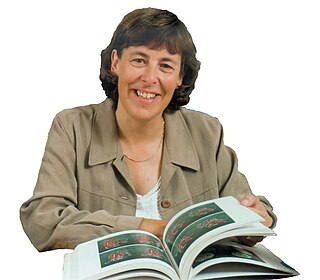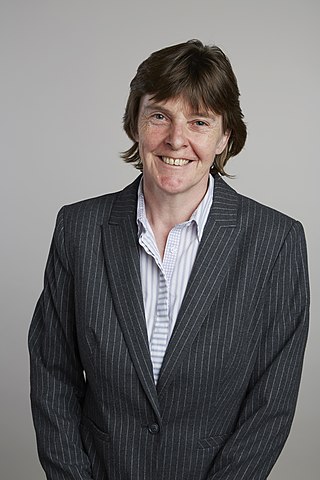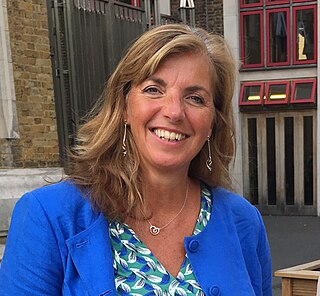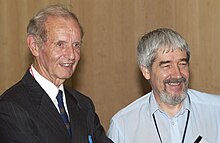The Science and Engineering Research Council (SERC) and its predecessor the Science Research Council (SRC) were the UK agencies in charge of publicly funded scientific and engineering research activities, including astronomy, biotechnology and biological sciences, space research and particle physics, between 1965 and 1994.
Sir Mark Edward Welland, is a British physicist who is a professor of nanotechnology at the University of Cambridge and head of the Nanoscience Centre. He has been a fellow of St John's College, Cambridge, since 1986 and started his career in nanotechnology at IBM Research, where he was part of the team that developed one of the first scanning tunnelling microscopes. He was served as the Master of St Catharine's College, Cambridge and took up office from 2016 to 2023.

Michael Ashburner was an English biologist and Professor in the Department of Genetics at University of Cambridge. He was also the former joint-head and co-founder of the European Bioinformatics Institute (EBI) of the European Molecular Biology Laboratory (EMBL) and a Fellow of Churchill College, Cambridge.

Sir Gregory Paul Winter is a Nobel Prize-winning English molecular biologist best known for his work on the therapeutic use of monoclonal antibodies. His research career has been based almost entirely at the MRC Laboratory of Molecular Biology and the MRC Centre for Protein Engineering, in Cambridge, England.
The Engineering and Physical Sciences Research Council (EPSRC) is a British Research Council that provides government funding for grants to undertake research and postgraduate degrees in engineering and the physical sciences, mainly to universities in the United Kingdom. EPSRC research areas include mathematics, physics, chemistry, artificial intelligence and computer science, but exclude particle physics, nuclear physics, space science and astronomy. Since 2018 it has been part of UK Research and Innovation, which is funded through the Department for Business, Energy and Industrial Strategy.

Dame Janet Maureen Thornton, is a senior scientist and director emeritus at the European Bioinformatics Institute (EBI), part of the European Molecular Biology Laboratory (EMBL). She is one of the world's leading researchers in structural bioinformatics, using computational methods to understand protein structure and function. She served as director of the EBI from October 2001 to June 2015, and played a key role in ELIXIR.

Michele Karen Dougherty is a Professor of Space Physics at Imperial College London. She is leading unmanned exploratory missions to Saturn and Jupiter and is Principal Investigator for J-MAG – a magnetometer for the European Space Agency's Jupiter Icy Moons Explorer, due for launch in April 2023.

David Tudor Jones is a Professor of Bioinformatics, and Head of Bioinformatics Group in the University College London. He is also the director in Bloomsbury Center for Bioinformatics, which is a joint Research Centre between UCL and Birkbeck, University of London and which also provides bioinformatics training and support services to biomedical researchers. In 2013, he is a member of editorial boards for PLoS ONE, BioData Mining, Advanced Bioinformatics, Chemical Biology & Drug Design, and Protein: Structure, Function and Bioinformatics.

Sir Mark Jeremy Walport is an English medical scientist and was the Government Chief Scientific Adviser in the United Kingdom from 2013 to 2017 and Chief Executive of UK Research and Innovation (UKRI) from 2017 to 2020. In 2023 he became the Foreign Secretary of The Royal Society.

Miles John Padgett is a Royal Society Research Professor of Optics in the School of Physics and Astronomy at the University of Glasgow. He has held the Kelvin Chair of Natural Philosophy since 2011 and served as Vice Principal for research at Glasgow from 2014 to 2020.

Susan C. Wray is professor of cellular and molecular physiology at the University of Liverpool. She also serves as the President of the International Union of Physiological Sciences (IUPS) and is president of the Federation of European Physiological Societies (FEPS). She was the founding editor-in-chief of Physiological Reports. and is the first editor-in-chief of Current Research in Physiology. She serves as director of the centre of better births in Liverpool Women's Hospital which was opened in 2013 with funding of £2.5 million with the objective of basic scientists working together with clinicians on problems during pregnancy. Along with Zarko Alfirevic, she leads the Harris wellbeing preterm birth centre. Wray is the director of the University of Liverpool Athena SWAN and team leader for the institute of translational medicine. Her primary research interests are in smooth muscle physiology, reproductive medicine and cell signalling.

Nicholas José Talbot FRS FRSB is Group Leader and Executive Director at The Sainsbury Laboratory in Norwich.

Paul Anthony Midgley FRS is a Professor of Materials Science in the Department of Materials Science and Metallurgy at the University of Cambridge and a fellow of Peterhouse, Cambridge.

Alison Mary Etheridge is Professor of Probability and former Head of the Department of Statistics, University of Oxford. Etheridge is a fellow of Magdalen College, Oxford.
Raymond Ethan Goldstein FRS FInstP is Schlumberger Professor of Complex Physical Systems in the Department of Applied Mathematics and Theoretical Physics (DAMTP) at the University of Cambridge and a Fellow of Churchill College, Cambridge.

Nikolay Zheludev is a British scientist specializing in nanophotonics, metamaterials, nanotechnology, electrodynamics, and nonlinear optics. Nikolay Zheludev is one of the founding members of the closely interlinked fields of metamaterials and nanophotonics that emerged at the dawn of the 21st century on the crossroads of optics and nanotechnology. Nikolay’s work focus on developing new concepts in which nanoscale structuring of matter enhance and radically change its optical properties.

David John Wales is a professor of chemical physics in the Department of Chemistry at the University of Cambridge.
Elizabeth M. C. Hillman is a British-born academic who is Professor of Biomedical Engineering and Radiology at Columbia University. She was awarded the 2011 Adolph Lomb Medal from The Optical Society and the 2018 SPIE Biophotonics Technology Innovator Award.

Clare Elwell is a British academic who is a professor of medical physics and director of the Near Infrared Spectroscopy Group and Biomedical Optics Research Laboratory at University College London. She has served as president of the International Society on Oxygen Transport to Tissue and the Society for Functional Near Infrared Spectroscopy.
Marina Denise Anne Jirotka is professor of human-centered computing at the University of Oxford, director of the Responsible Technology Institute, governing body fellow at St Cross College, board member of the Society for Computers and Law and a research associate at the Oxford Internet Institute. She leads a team that works on responsible innovation, in a range of ICT fields including robotics, AI, machine learning, quantum computing, social media and the digital economy. She is known for her work with Alan Winfield on the 'Ethical Black Box'. A proposal that robots using AI should be fitted with a type of inflight recorder, similar to those used by aircraft, to track the decisions and actions of the AI when operating in an uncontrolled environment and to aid in post-accident investigations.














